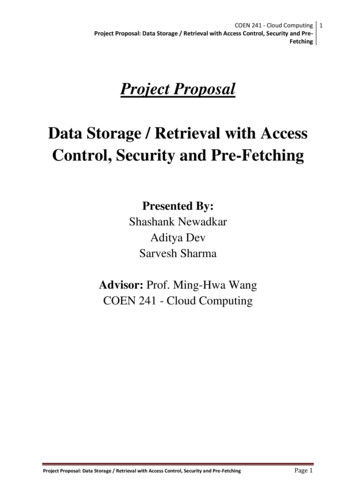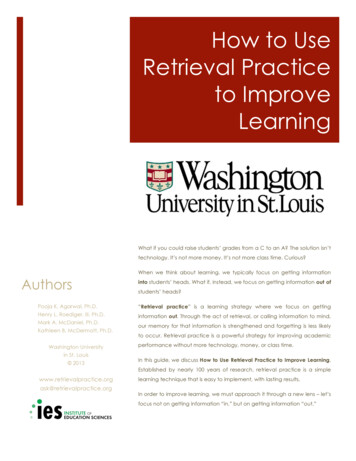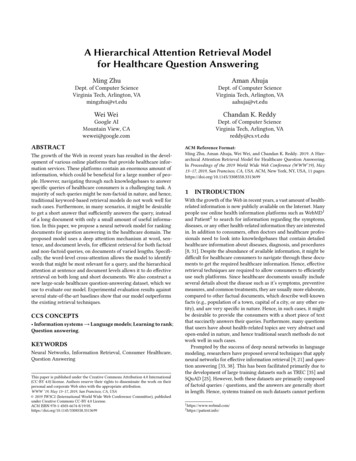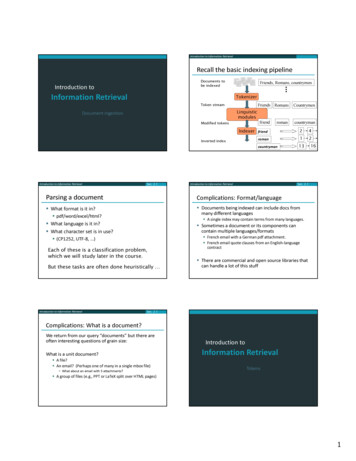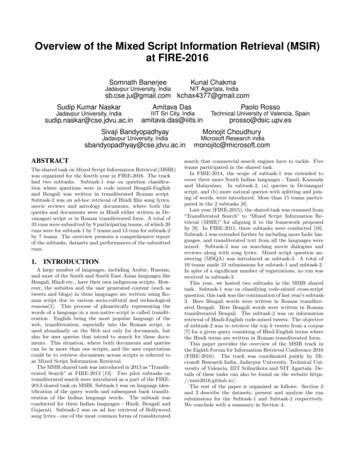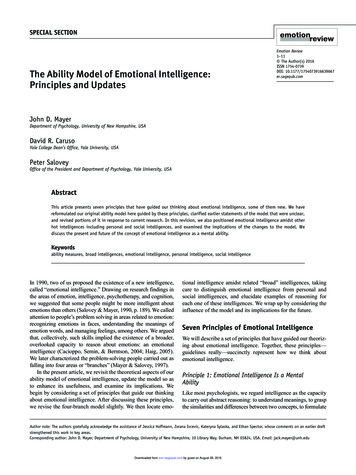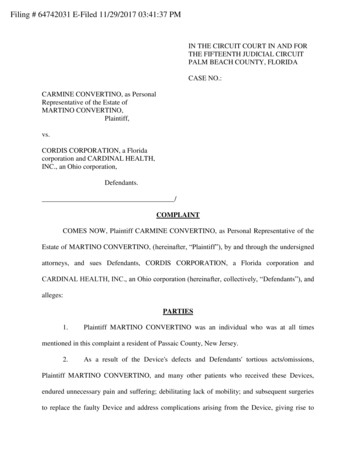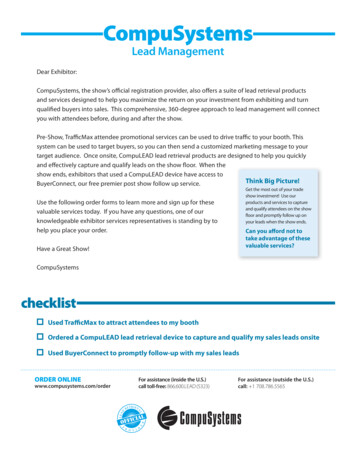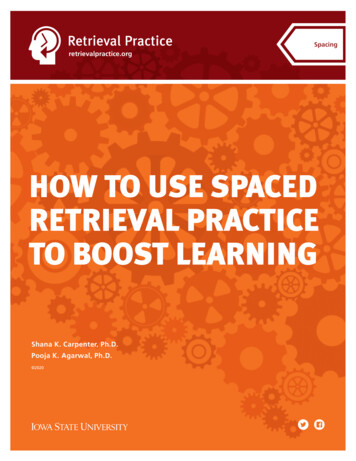
Transcription
Retrieval PracticeSpacingretrievalpractice.orgHOW TO USE SPACEDRETRIEVAL PRACTICETO BOOST LEARNINGShana K. Carpenter, Ph.D.Pooja K. Agarwal, Ph.D. 2020
HOW TO USE SPACED RETRIEVAL PRACTICE TO BOOST LEARNINGIf you want to improve students’ grades, where should you start?Conventional wisdom tells us that the key to mastery is to spend moretime learning. A student who performs poorly on an exam is likely tospend more time studying for the next one. And a teacher who witnessesher students struggling to grasp a difficult concept is, understandably,likely to spend more time teaching that concept in the future.But, is more always better? We know that retrieval practice is the key to successful learning. Just likea workout, retrieval exercises our “memory muscles” and strengthens learning.[1] So more retrievalpractice, just like more exercise, should lead to better results, right? If a student wishes to score higheron her next Spanish exam, she should spend more time practicing retrieval of her Spanish vocabularyand grammar rules.However, research reveals that the key to successful learning via retrieval is not so much the total timespent learning, but the way in which that time is distributed. “Spaced practice” is a technique thatcan drastically improve learning without changing the amount of time spent learning.In this guide, we discuss how to use spaced practice to improve learning. This technique—supported byhundreds of studies and over a century of research—is simple and easy to implement, works for any typeof learning, and produces long-lasting results.retrievalpractice.org2
HOW TO USE SPACED RETRIEVAL PRACTICE TO BOOST LEARNINGWHAT IS SPACED PRACTICE?Spaced practice involves taking a given amount of time devoted to learning, and arranging that timeinto multiple sessions that are spread over time. In this way, the learning sessions are said to be “spaced”apart in time. This can be compared to the more popular approach—known by many as “cramming”—inwhich students do all or most of their studying in one long session shortly before the exam.[2]For example, the night before a Spanish exam a student might study 50 vocabulary words by repeatedlytrying to retrieve the English translation for each of the Spanish words (Zapato – Shoe). Let’s say thestudent goes through the whole list three times practicing retrieval of the translations. An alternativeapproach is to practice retrieving the translations for the list of 50 vocabulary words on three separateoccasions—one time a week before the exam, again a few days later, and again a few days after that.Critically, both approaches involve the same amount of time learning, but differ in how that time isscheduled. Simply spacing learning opportunities across multiple days leads to much higherachievement than studying the same amount of information all in one session.retrievalpractice.org3
HOW TO USE SPACED RETRIEVAL PRACTICE TO BOOST LEARNINGIn one study, high school students learned French vocabulary words via threeclassroom exercises that involved retrieving and using their knowledge ofFrench: the exercises occurred back-to-back on the same day or they occurredonce per day over three days.Each lesson was 10 minutes long, so students either completed 30 minutes of exercises in one classsession, or 10 minutes of exercises per day over three days. Several days after the lessons were completed,all of the students were given an unexpected test. Contrary to what we might expect, students whocompleted the exercises across three days performed better than the students who completed theexercises on the same day.[3] In other words, even though the two groups of students spent thesame amount of time learning the material, the group that spaced out that time over differentdays learned it significantly better.Spaced Practice(3 lessons over three days)Lesson 1Lesson 2Lesson 3(10 minutes)(10 minutes)(10 minutes)1 day1 day1 day7 daysLesson 1UnannouncedTest(10 minutes)Lesson 2Massed Practice(3 lessons over the same day)(10 minutes)7 daysLesson 3(10 minutes)Results10090Mean Test Score80706075%5055%403020100Spaced PracticeMassed Practice(3 lessons over three days)(3 lessons over the same day)retrievalpractice.org4
HOW TO USE SPACED RETRIEVAL PRACTICE TO BOOST LEARNINGWHY DOES SPACING WORK?When students encounter information repeatedly in one session, it quickly becomes familiar—whatwe call an “illusion of knowing.” The English translation for a Spanish vocabulary word readily comesto mind if it was just retrieved moments ago (Zapato - ?). However, when information is quicklyacquired, it’s often quickly forgotten. Immediate repetition helps students remember something for ashort time—i.e., just a few seconds or minutes later—but only because that information is in short-termmemory. It can be much more difficult to remember the information after a week, or even a day. Thus,cramming increases the amount of information in short-term memory, but it does not improvelong-term memory.In spaced sessions studentsengage in increased effortto retrieve the information,which improves thedurability of learning.Based on a wealth of research, we also know that cramming feels easier than spacing, but informationlearned through cramming is temporary and shallow. In contrast, when learning opportunities are spacedapart, students engage in increased effort to retrieve the information, which improves the durability oflearning – what we call a “desirable difficulty.” Similar to why retrieval practice works, when studentshave to retrieve things from memory and think deeply about what they are learning, they are morelikely to remember the information over the long-term.[4] When using spaced practice, retrieving theinformation across sessions will not always be easy, and students will have to try harder to remember it.This can lead students to feel like they are not learning very well from spaced practice, but that’s preciselywhy spacing works – the challenge from spacing dramatically improves long-term learning.[5]retrievalpractice.org5
HOW TO USE SPACED RETRIEVAL PRACTICE TO BOOST LEARNINGWHAT TYPES OF LEARNING BENEFIT FROM SPACING?First, spaced practice improves students’ long-term learning of academicknowledge and skills in language, math, science, and social studies.Students who engage in spaced practice learn the concepts better and also show enhancedunderstanding—not just memorization—of how the concepts apply to new situations. Being able toapply knowledge to a new situation is known as transfer of learning, and is an important goal ofeducation.[6]For example, in one study, elementary school children learned scientific information about food chains—such as the tendency for larger animals to eat smaller animals, and the tendency for the number ofspecies to increase when they have more food to eat.[7] The children received four lessons that involvedhands-on demonstrations and questions about the information they were learning. The four lessonsoccurred on the same day, or once per week across four weeks. The children who received the once-perweek, or “spaced,” lessons learned the information better. On a later test over what they had learned,the spaced group not only performed better on questions over the basic concepts (for example, “Biggeranimals typically eat animals”), they also showed greater transfer of learning to new questions(“What does the frog eat?”) and questions that required fairly complex transfer (“Let’s say that all thefrogs get captured and taken away by hunters. What happens to the number of turtles? Does it go up,down, or stay the same?”). Thus, spaced practice improves children’s ability to not only retain knowledgethey have learned, but also to use that knowledge in different ways.Iciis si verumquis sendis utvolo in nossitomniat eturmodicipietretrievalpractice.org6
HOW TO USE SPACED RETRIEVAL PRACTICE TO BOOST LEARNINGSecond, the benefits of spaced practice last over time.In one study, middle school students retrieved information from their science lessons either right afterthe lessons ended, or a few days after the lessons.[8] On exams given at the end of the semester, studentsperformed better when retrieval practice was spaced a few days after the lessons instead of rightafterwards. In another study, middle school students reviewed information from their history class byanswering review questions either soon after they learned the material, or several weeks after theylearned it.[9] When both groups were given an unexpected test over the information nine months later,the group that reviewed after several weeks scored significantly higher. Maintaining knowledge over thecourse of a semester, or after a nine-month interval—equivalent to an academic year at many schools—shows that learning information through spaced practice leads to long-lasting and durable knowledgeover time.Third, spaced practice benefits diverse students—from young childrenlearning their first concepts about the world, all the way to medical studentslearning how to perform surgical operations.One study found that medical students were more successful in performing a surgery if they had practicedthe surgical skills in four spaced sessions that occurred once per week over four weeks, compared tofour sessions that occurred on the same day.[10] To the patient undergoing surgery, the value of spacedpractice cannot be overstated!Spaced practice leads tolong-lasting and durableknowledge over time.retrievalpractice.org7
HOW TO USE SPACED RETRIEVAL PRACTICE TO BOOST LEARNINGHOW CAN I IMPLEMENT SPACED PRACTICE?The good news is, the advantages of spaced practice can be readilyobtained, and spaced practice can be implemented in a number of ways.The key to spaced practice is to provide opportunities for students toengage with material they are learning on multiple occasions that areseparated in time. This can be done in a number of ways:Break up lessons into smaller sessions.Instead of teaching one long lesson over a topic, divide up the lesson into smaller lessons and spacethem over multiple days. For example, in teaching students to conjugate verbs in a foreign language,conjugation rules can be introduced and practiced in a brief session, followed by additional practicewith the same rules on subsequent days. The same goes for any academic material, such as practicingmathematical procedures, practicing to recall terms and definitions, comparing and contrasting differentconcepts, or generalizing knowledge to new situations.Revisit concepts that have been taught in previous class meetings.It is easy for us as teachers to think that once a topic has been “covered,” there is no need to cover itagain. To the contrary, students who are learning information for the first time need to revisit it, thinkabout it more, and process it multiple times. Such opportunities can be provided by working into classlessons some of the concepts that had been encountered in previous lessons. These can take the form ofclass discussions, class activities, or homework assignments that require students to retrieve previouslylearned information and relate it to new concepts.Harness technology to help students set a spaced study schedule.Students can use a number of accessible online tools—such as online flashcards or electronic calendars—to create and set a schedule with built-in reminders for studying course information. With the help ofonline course management systems, teachers can also set regular (i.e., daily or weekly) review quizzesand other assignments designed to provide spaced retrieval practice of the concepts being learned.Include cumulative retrieval practice.Cumulative quizzes and exams require students to maintain proficiency with information they havelearned earlier in the course. Cumulative retrieval practice involves spacing by including concepts learnedat earlier points in the course, and it also encourages students to review previously-learned information inorder to prepare for the exams. Always make sure to use spacing as a learning strategy throughout thesemester or school year, not simply as part of high-stakes assessments.retrievalpractice.org8
HOW TO USE SPACED RETRIEVAL PRACTICE TO BOOST LEARNINGWHAT ARE POTENTIAL CHALLENGES WHEN IMPLEMENTINGSPACED PRACTICE?Learning through spacing can feel slow and ineffective.When students try to retrieve information after time has passed, they will notice that they have forgottensome (or even most) of it. This could create a sense of discouragement and the feeling that they are notlearning. In reality, however, information that was once learned can be re-learned with less effort, and aspaced schedule allows opportunities to retrieve information after some time has passed in order to seewhat needs to be re-learned and what is already known, optimizing the use of study time.Using spacing can require an organized schedule.Teachers who wish to incorporate spacing into their classes might find it challenging at first to coversmaller portions of information across multiple days, or to incorporate previously-taught concepts intocurrent lessons. Structuring a class to incorporate spaced practice requires some planning. Importantly,however, it does not require major restructuring or overhauls to the course, but rather a redistribution ofthe same amount of time that will already be spent on each lesson.Students may not use spaced practice on their own.Students often opt to study information by cramming a couple of days before the exam. To encouragespaced studying, teachers can provide review activities (e.g., retrieval practice and brief quizzes) orassignments on a daily or weekly basis.To encourage spacedstudying, teachers canprovide retrieval activitiesor assignments on a dailyor weekly basis.retrievalpractice.org9
HOW TO USE SPACED RETRIEVAL PRACTICE TO BOOST LEARNINGFREQUENTLY ASKED QUESTIONSHow much spacing is enough?In general, the more, the better. Spaced practice is beneficial whether the lessons occur on consecutive days,one week apart, or even several weeks apart. Research shows that any spacing is better than no spacing,and exactly how much time should occur between learning sessions is less critical. Teachers and learnersshould strive to space information across multiple days at long enough intervals that encourage challengingretrieval conditions—i.e., “desirable difficulties—but these intervals can be flexible and adjusted accordingto course schedules and the specific material being learned.Should spacing schedules always be the same?When students learn information across several sessions, should time in-between the sessions increase,decrease, or stay the same? Research shows that slight differences in the timing between sessions does nothave a large effect on learning. Students can complete two lessons with one day in-between, with five daysin-between, and so on. Compared to learning the information in a single longer session, spacing benefitslearning regardless of whether the time between lessons is equal or non-equal.retrievalpractice.org10
HOW TO USE SPACED RETRIEVAL PRACTICE TO BOOST LEARNINGHow should students learn information during spaced practice?By far the most effective way to learn is to use retrieval practice. When students try to recall information,instead of just reading it, they learn it much better. In particular, repeated attempts to recall information,followed by reviewing the correct answers through informative feedback, are particularly effective forbuilding solid and reliable long-term learning and transfer of knowledge. Although spacing still benefitslearning even when students acquire the information purely through reading or listening to a lecture,spacing is even more effective when students learn by using retrieval practice.How many spaced sessions should there be?Again, the more, the better. For long-term durable learning, teachers and learners should strive to re-visitinformation over spaced time intervals as many times as possible. The exact number of spacing sessionsthat can be incorporated, and the time intervals in-between, might depend on the particular course andinformation being learned. The good news is, spacing benefits learning regardless of how many sessionsthere are—making it a flexible and adaptive tool that can be tailored to any learning situation—andbenefits learning to a greater extent the more it can be utilized.What should students do in-between spaced learning sessions?Spacing benefits learning regardless of what students do in-between the spaced sessions. If studentspractice conjugating verbs in Spanish and then practice the same conjugation rules on a later day,they can engage in any number of activities in-between the two sessions—learning history, science,mathematics, or even conjugation rules in a different language. The key to spacing is to allow time tooccur in-between two or more learning sessions, but exactly how that time is spent is less critical. In fact,research has shown that lessons over two or more topics can be alternated, or “interleaved,” to providespaced practice and also practice at comparing and contrasting the similarities and differences betweenthe content in the two lessons.[11]retrievalpractice.org11
For research, resources, and tips, visit retrievalpractice.org 2020 The development of this guide was supported by Iowa State University and the James S. McDonnell Foundation Twenty-First Science Initiative inUnderstanding Human Cognition, collaborative grant 220020483. Any opinions, findings, conclusions, or recommendations expressed are those of theauthors and do not reflect the views of Iowa State University or the McDonnell Foundation.This guide by RetrievalPractice.org is licensed under Creative Commons BY-NC-ND.Retrieval rievalpractice.org/RetrievalPractice
practice, just like more exercise, should lead to better results, right? If a student wishes to score higher on her next Spanish exam, she should spend more time practicing retrieval of her Spanish vocabulary and grammar rules. However, research reveals that the key to succes
